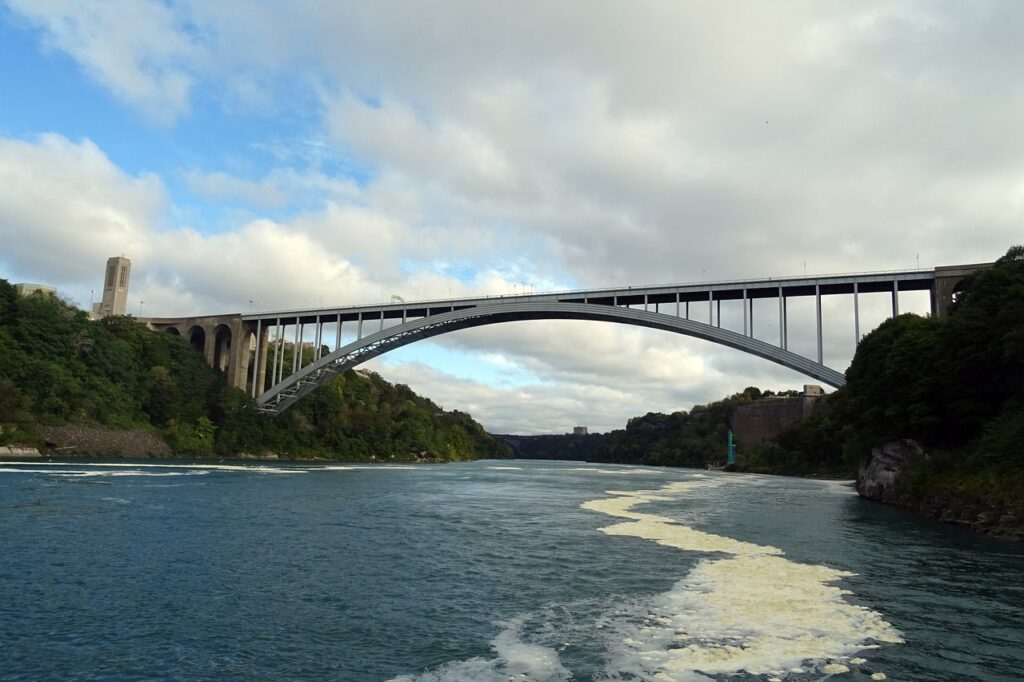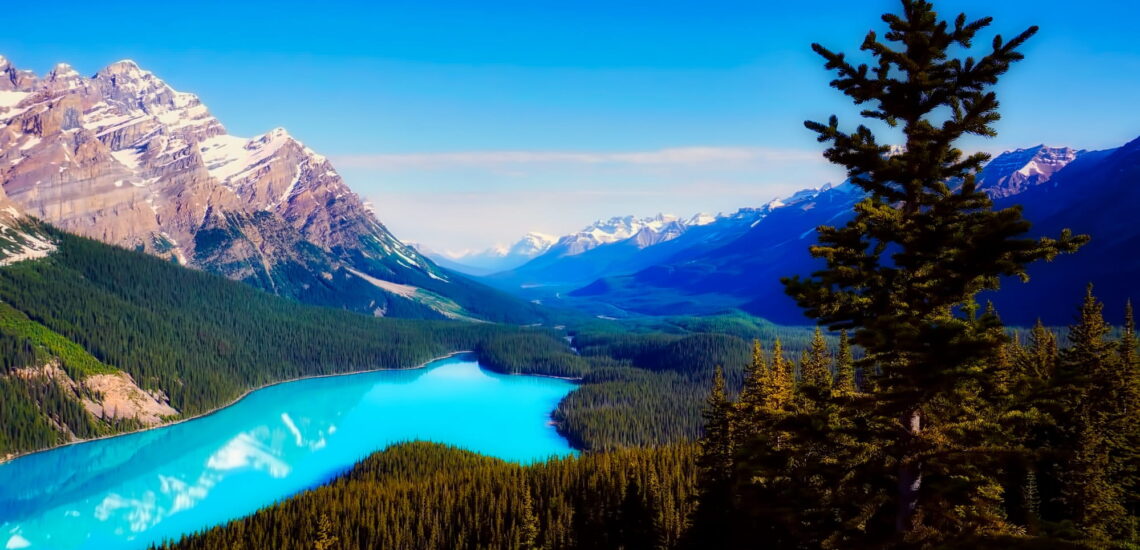10 Interesting Facts About Canada
Quick facts about Canada:
- Population: Approximately 39 million people.
- Capital: Ottawa.
- Official Languages: English and French.
- Currency: Canadian Dollar (CAD).
- Government: Federal parliamentary democracy and constitutional monarchy.
- Major Religion: Christianity, with a diverse range of denominations including Catholicism, Protestantism, and other faiths, alongside growing religious diversity.
- Geography: Located in North America, bordered by the United States to the south and northwest, with the Atlantic Ocean to the east, the Pacific Ocean to the west, and the Arctic Ocean to the north.
Fact 1: Most of Canada’s population lives on its southern border
Canada’s southern border, which it shares with the United States, is where the country’s most populous provinces are located, including Ontario, Quebec, and British Columbia. These provinces are home to major cities such as Toronto, Montreal, and Vancouver, which have large urban populations and serve as economic and cultural centers.
Several factors contribute to the concentration of population in southern Canada. Historically, settlement patterns were influenced by accessibility to transportation routes, natural resources, and agricultural land. The southern regions of Canada benefit from milder climates, fertile soils, and proximity to transportation networks, making them more attractive for settlement and economic development.

Fact 2: Canada’s largest producer of maple syrup
Maple syrup production is a significant industry in Canada, particularly in the province of Quebec, which accounts for the majority of the country’s maple syrup production. Other Canadian provinces, including Ontario, New Brunswick, and Nova Scotia, also produce maple syrup, albeit in smaller quantities.
The process of maple syrup production involves tapping sugar maple trees during the spring thaw, collecting the sap, and then boiling it down to concentrate the sugars and create maple syrup. This process requires specific weather conditions, with freezing temperatures at night and warmer temperatures during the day, which are typical in many regions of Canada during the spring.
Fact 3: Hockey is widely regarded as Canada’s national winter sport
From coast to coast, Canadians embrace hockey as more than just a game; it’s a shared passion that brings communities together and fosters a sense of national pride. The sport is celebrated in various ways, including through youth leagues, adult recreational leagues, collegiate competitions, and professional hockey at the highest levels.
In addition to playing the game, Canadians avidly follow professional hockey leagues such as the National Hockey League (NHL), where many Canadian teams compete alongside American franchises. The annual Stanley Cup playoffs, the pinnacle of professional hockey, captivate millions of Canadian fans who cheer for their favorite teams and players.
 Jeffery Simpson, CC BY-NC-SA 2.0
Jeffery Simpson, CC BY-NC-SA 2.0Fact 4: Canada has the largest moose population in the world
Canada’s vast wilderness areas provide ample habitat and resources for moose, allowing them to thrive in different ecosystems. However, estimating the exact size of Canada’s moose population is challenging due to factors such as habitat fragmentation, migration patterns, and variations in survey methods.
They are well-adapted to various habitats and are found in almost every Canadian province and territory, with particularly dense populations in regions such as Newfoundland and Labrador, Ontario, Quebec, British Columbia, and Alberta.
Fact 5: Canada’s coastline is over 200,000 kilometers long
Canada boasts one of the longest coastlines in the world, thanks to its vast network of shores along the Atlantic, Pacific, and Arctic Oceans. However, the total length of Canada’s coastline is estimated to be approximately 202,080 kilometers (125,570 miles), including all mainland and island coastlines. This measurement takes into account the intricate details of the coastline, such as bays, inlets, and fjords, which significantly contribute to its overall length.
Canada’s coastline encompasses a diverse range of landscapes, from rugged cliffs and sandy beaches to rocky shores and remote coastal islands. It supports rich biodiversity, including various marine habitats, coastal ecosystems, and wildlife species.
Note: Before traveling to Canada, find out here if you need an International Driver’s License to rent and drive a car.

Fact 6: Canadians love mac and cheese
Macaroni and cheese is a classic comfort food that consists of cooked macaroni pasta combined with a cheese sauce, typically made from cheddar or other types of cheese. It is a versatile dish that can be served as a main course or as a side dish, and it is often customized with additional ingredients such as bacon, vegetables, or breadcrumbs.
In Canada, mac and cheese holds a special place in the culinary culture and is enjoyed by people of all ages. It is commonly found on restaurant menus, in ready-to-eat meals, and as a homemade dish prepared for family gatherings, potlucks, and special occasions.
Fact 7: Canada is famous for its lakes
Canada is home to a vast number of lakes, ranging in size from small ponds to expansive bodies of water. The country boasts more lakes than any other nation in the world, with estimates ranging from 2 million to over 3 million lakes, depending on the criteria used for classification.
Some of Canada’s most famous lakes include:
- Great Bear Lake: Located in the Northwest Territories, Great Bear Lake is the largest lake entirely within Canada and the eighth largest in the world by surface area.
- Great Slave Lake: Also situated in the Northwest Territories, Great Slave Lake is the second largest lake within Canada and the deepest lake in North America.
- Lake Superior: Shared with the United States, Lake Superior is the largest of the Great Lakes by surface area and the largest freshwater lake by surface area in the world.
- Lake Ontario: Another of the Great Lakes, Lake Ontario forms part of the border between Canada and the United States and is renowned for its scenic waterfronts and recreational opportunities.
- Lake Louise: Nestled in Banff National Park in Alberta, Lake Louise is famous for its stunning turquoise waters and picturesque mountain scenery, attracting visitors from around the world.

Fact 8: Hawaiian pizza is actually from Canada.
Hawaiian pizza is a popular pizza variety that originated in Canada in the early 1960s. It is credited to Sam Panopoulos, a Greek immigrant who owned a restaurant in Chatham, Ontario, called the Satellite Restaurant.
Panopoulos and his brothers experimented with various pizza toppings to create new flavor combinations, and they decided to add canned pineapple and ham to a traditional pizza base. They named the creation “Hawaiian pizza,” likely inspired by the brand of canned pineapple used.
The combination of sweet pineapple and savory ham quickly gained popularity among customers, and Hawaiian pizza became a staple offering on the menu of the Satellite Restaurant. Over time, it spread to other pizzerias in Canada and eventually became popular internationally.
Fact 9: One-tenth of the planet’s forests are in Canada
Canada is renowned for its vast expanses of forested land, which cover approximately 347 million hectares (about 857 million acres) or roughly 9% of the world’s total forest area. This makes Canada one of the leading countries in terms of forested land, second only to Russia in total forest area.
The country’s forests are incredibly diverse, encompassing boreal forests, temperate rainforests, mixed wood forests, and other ecosystems. They provide habitat for a wide range of plant and animal species, support Indigenous cultures and livelihoods, contribute to carbon storage and climate regulation, and offer opportunities for recreation, tourism, and resource extraction.
 GRID-Arendal, CC BY-NC-SA 2.0
GRID-Arendal, CC BY-NC-SA 2.0Fact 10: The name of the country comes from a native word
The name “Canada” is believed to have originated from the St. Lawrence Iroquoian word “kanata,” which means “village” or “settlement.” The French explorer Jacques Cartier first encountered the term in the early 16th century when he used it to refer to the region near present-day Quebec City. The indigenous people he encountered may have been referring to their village or settlement when using the word “kanata.”
Over time, the name “Canada” came to be associated with the entire territory explored by Cartier and later French and British explorers, encompassing much of present-day eastern Canada. When British North America was formed in the 18th century, the name “Canada” was retained, eventually becoming the official name of the country upon its confederation in 1867.





